The pied imperial pigeon is a relatively large, plump species of pigeon found in southeast Asia and Northern Australia.
Its most distinguishing feature is its pied coloring.
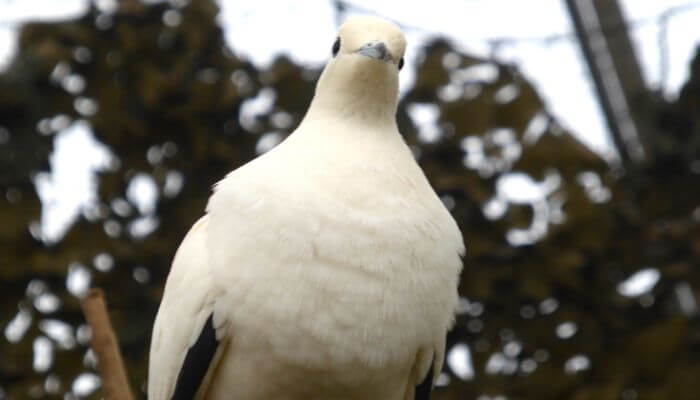
Though commonly known in most places as the pied imperial pigeon, this particular species of bird is also known in different locations as the Torresian imperial pigeon, Torres Strait pigeon, white nutmeg pigeon, nutmeg pigeon, spice pigeon, or Australian pied imperial pigeon.
Origins of the Pied Imperial Pigeon
The Pied Imperial Pigeon belongs to the Ducula genus of the Columbidae family, which was first introduced by English naturalist Brian Houghton Hodgson in 1836.
It is considered to be a subspecies of the mountain imperial pigeon (Ducula badia).
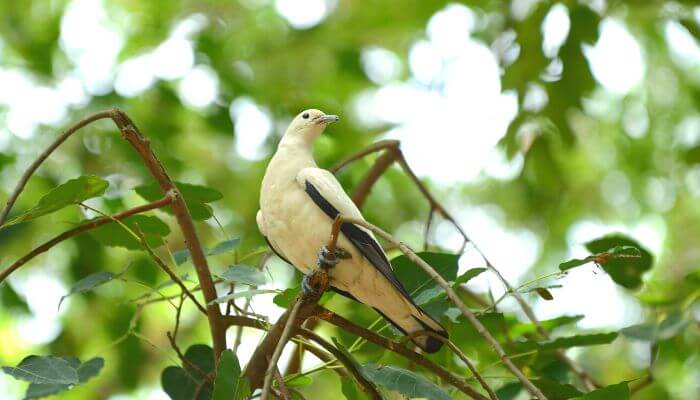
An earlier claim to fame is that it appears to have been the first Australian bird recorded by Europeans.
On Luis Vaez de Torres’s voyage through the eponymous Torres Strait in 1606, Diego de Prado noted “plenty of very large pigeons all white”.
Distribution And Habitat of the Pied Imperial Pigeon
The pied imperial pigeon can be found happy and thriving in locations like coastal woodland, forest, mangrove, scrub and plantations all across Southeast Asia.
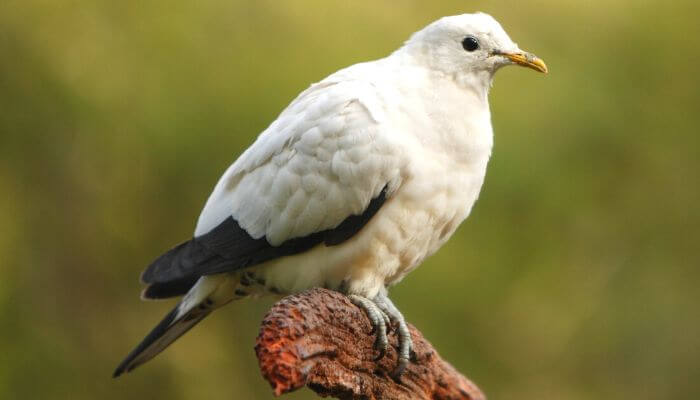
It is a very far-ranging species with its distribution being from the western Bay of Bengal eastward to the Philippines and south through Indonesia and New Guinea to northern Australia.
This includes countries including Myanmar, Thailand, New Guinea, Cambodia, Vietnam and Brunei.
The pied imperial pigeon prefers small islands and the edges of coastal regions and though wide-ranging, there are few large populations in any one area.
Status of the Pied Imperial Pigeon
The pied imperial pigeon is a bird that remains locally common in all of its prevalent distribution locations, and although population numbers have decreased slightly over the last few decades mainly due to lost habitat and human predation, the species is still classed as being of ‘Least Concern’ by both BirdLife International and the IUCN.
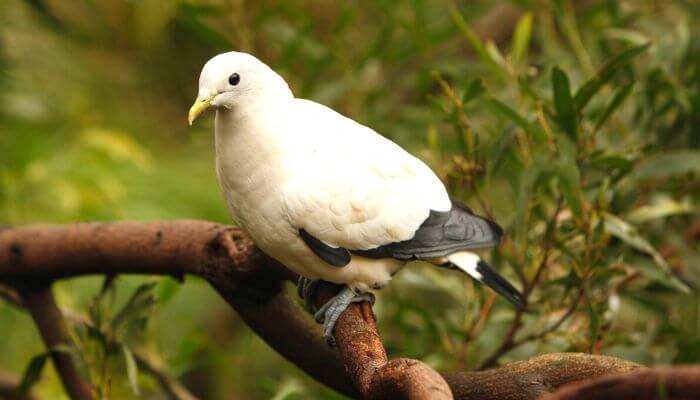
The pied imperial pigeon has been a protected species in Australia since 1902.
Appearance of the Pied Imperial Pigeon
| Wingspan | Length | Weight | Coloring | |
|---|---|---|---|---|
| Pied Imperial Pigeon | 46 cm | 38 – 45 cm | 450-500 g | Piebald |
| Average Feral Pigeon | 64 – 72 cm | 32 – 37 cm | 300 – 500 g | Bluish grey with some black |
The pied imperial pigeon is a largish, plump pigeon.
It is distinctively white and black.
They are mostly white with black on the outer parts of the flight feathers and tail tip.
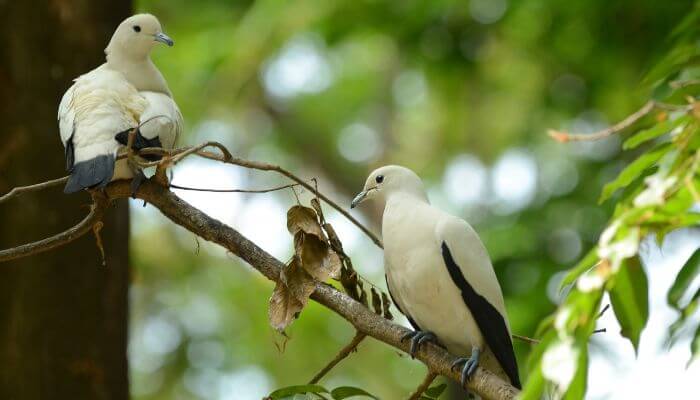
There are also black bars on the underside of its tail.
This pigeon has a yellow or yellow/green beak. Its legs and feet are blueish grey.
The iris of the eye is brown.
Something that you might notice when viewing certain pied imperial pigeons is that they might appear to have a brown head, but this isn’t due to natural coloring.
Rather, it is a product of the feathers being soiled by the bird’s attempts to eat fruit from the ground!
The Pied Imperial Pigeon looks very similar to the rare Silvery Pigeon. In fact, the Silvery Pigeon was once thought to be extinct because many sightings were misattributed as Pied Imperial Pigeons.
Pied Imperial Pigeon Character
One of the leading characteristics of the pied imperial pigeon is that it is a very fast and direct flier.
Characteristic of most pigeons, the flight has a regular beat with an occasional sharp wing flick.
Being migratory birds, they travel in flocks at either dawn or dusk.
Interestingly, they have more powerful flight muscles than several relatively larger bird species, which allows them to cross larger bodies of water when traveling from island to island.
They are considered to be among the most agile and powerful flyers in the bird world.
Feather maintenance is something that is very important to the pied imperial pigeon.
You will often observe them preening their feathers, having powder downs and rain bathing to keep their feathers in optimal condition for both flying and attracting a mate.
This species is quite gregarious and has a number of different calls.
Common communicative calls are loud and low-pitched and sound like ‘roo ca hoo’, ‘mrrroooooo’ and ‘up ooooo’.
Their display call used in courtship (and also when being aggressive) is loud, bellowing and low-pitched “coo-hoo-hoo” or “oom-oom-oom”.
Diet of the Pied Imperial Pigeon
As an arboreal dove (tree-dwelling), the pied imperial pigeon feeds almost exclusively on fruit that grows on tropical trees, vines, palms and bushes.
Preferred eating places are in the dense tree canopies but will also feed in small trees and ground shrubs when the fruit is inviting.

Island-dwelling birds regularly fly in flocks to the mainland to feed, dispersing to eat.
Pied Imperial Pigeons are able to swallow fruits that contain very large seeds, and after all of the nutritious pulp and flesh has been removed, these seeds are later regurgitated or excreted whole depending on their size.
Pied Imperial Pigeon Mating And Breeding
The pied imperial pigeon has adapted its breeding process to location.
They will breed in a tree in a small to large colony having built a rather untidy nest.
But they will also breed on the ground.
No nest is built as such but a nesting site is encircled by mounds of excreted fruit seeds.
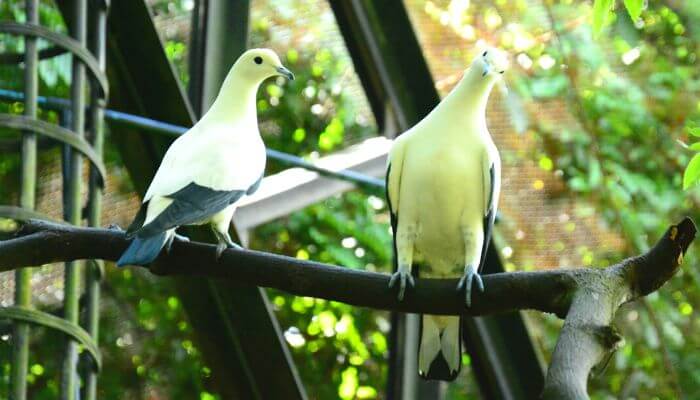
will begin its breeding process by building a rather untidy nest in a tree (usually a coconut palm). It will then lay one to three eggs which will hatch within the next 23 to 25 days.
They may produce three clutches of eggs in one season.
Both male and female incubate the eggs on alternate days and both brood and feed the chicks, again on alternate days.
Pied imperial pigeon squabs tend to fledge about three weeks after birth.
Across Southeast Asia, the breeding season for these birds tends to be between August and January, when the conditions are optimal for breeding among vines, mangroves and palm fronds on offshore islands.
Taking Care of Pied Imperial Pigeons
This is a wild species and not suitable for domestication.
Pied imperial pigeons can be seen in the wild or in zoos where they will usually be part of a conservation programme.
In terms of caring for the species, the best thing that you can do as a bird lover is to make sure that you don’t interrupt, damage or destroy the habitats we have mentioned above which are the favored environments and breeding grounds for the wonderful pied imperial pigeon.
